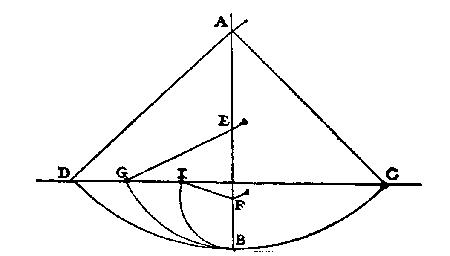

| Home | > | Demo Index | > | Mechanics Index |
Equipment: A 1.5" diameter wooden ball on a string, a magnetic mount, a rod on a magnetic mount, chalk, a meter stick and a magnetic blackboard or whiteboard.
What it does: The pendulum is released and the height of the swing is recorded. A rod is then placed in the way of the pendulum and the process is repeated. The height of the swing with the rod is the same as without the rod.
Concepts Demonstrated: Conservation of mechanical energy.
Classroom assembly:
Cautions: Practice this demo in advance to drop the ball smoothly and avoid hitting the blackboard. Do not use a heavy bob as it may pull free from the mount or the blackboard.
Setup Time: Short.
Difficulty: Straightforward.
Visibility: Medium. The motion of the pendulum is visible in a large lecture hall, but the height marks on the blackboard are not.
"Imagine this page to represent a vertical wall, with a nail driven into it; and from the nail let there be suspended a lead bullet of one or two ounces by means of a fine vertical thread, AB, say from four to six feet long, on this wall draw a horizontal line, DC, at right angles to the vertical thread AB, which hangs about two finger-breadths in front of the wall. Now bring the thread AB with the attached ball into the position AC and set it free; first it will be observed to descend along the arc CBD, to pass the point B, and to travel alongthe arc BD, till it almost reaches the horizontal CD, a slight shortage being caused by the resistance of the air and the string; from this we may rightly infer that the ball in its descent through the arc CB acquired a momentum [impeto] on reaching B, which was just sufficient to carry it through a similar arc BD to the same height. Having repeated this experiment many times, let us now drive a nail into the wall close to the perpendicular AB, say at E or F, so that it projects out some five or six finger-breadths in order that the thread, again carrying the bullet through the arc CB, may strike upon the nail E when the bullet reaches B, and thus compel it to traverse the arc BG, described about E as center. From this we can see what can be done by the same momentum [impeto] which previously starting atthe same point B carried the same body through the arc BD to the horizontal CD. Now, gentlemen, you will observe with pleasure that the ball swings to the point G in the horizontal, and you would see the same thing happen if the obstacle were placed at some lower point, say at F, about which the ball would describe the arc BI, the rise of the ball always terminating exactly on the line CD. But when the nail is placed so low that the remainder of the thread below it will not reach to the height CD (which would happen if the nail were placed nearer B than to the intersection of AB with the horizontal CD) then the thread leaps over the nail and twists itself about it."
Related demonstrations:
References: PIRA 1M40.15
VideoEnc 03-13
Sutton M-132;DHP Mr-3; DaR M-414; JSMiller p102
Original Construction: The magnetic mounts were purchased. An eye hook was screwed into the wooden ball and a string was attached. The rod is a 4" length of aluminum bar.
| Home | > | Demo Index | > | Mechanics Index |